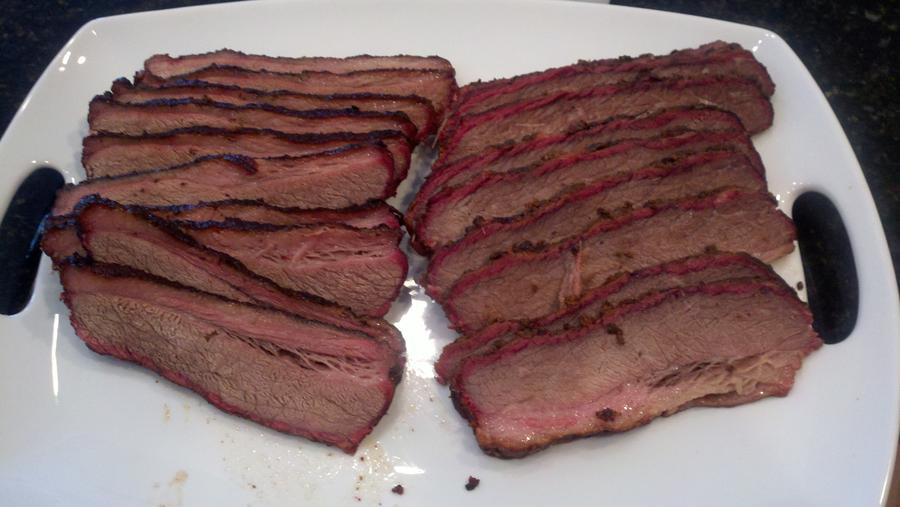Yeah, getting the timing down that close is a pretty good hit...rare, IMHO. Well done on that! Looks really good at first glance...let's take a closer look and see where you're coming from, but before I do, my first thoughts are...
Dried out right after slicing...hmm...probably just surface moisture from the meat fibers escaping to atmosphere...it happens. But if lack of tenderness and a dry chew were noticed, they are linked together, to some degree.
How moist is your smoke chamber, normally? Do you use a water pan, or just a baffle plate over the coal basket? 195* may have been just a bit high for finished temps, but I have taken them that high for slicing before, and did notice a bit of dryness...but I have also have experienced worse for dryness, too, with lower finished temps.
OK, another thought: how long did you rest before slicing, and was the foil bundle wrapped in a towel to keep it hot longer? When resting, you want temps to drop off slowly, or else meat juices may not have time to redistribute thoroughly. You should see some juices on the board while slicing if it's too hot to cut, didn't rest long enough, or temps fell of too quickly.
***I clicked on the photo to enlarge and get a better idea, and in doing so, I see a good smoke ring, so the smoke chamber humidity must be at least moderate to high, and also realizing you're burning charcoal or lump, they help to produce a lot of NO2, which is actually what builds the smoke ring. I find that high humidity helps for even better smoke reaction and smoke ring development.
With lean muscle such as the flat (low to no inter-muscular fat), they are more susceptible to drying out when finished at higher internal temps. Keeping the fat cap on helps reduce this internal moisture loss, but reduces smoke reaction under the fat cap, so it's kind of a compromise to have surface fat.
Now, here's where I may raise a few arguments, though I have tested this theory on lean-trimmed pork butts and have not had the opportunity to test it on leaner meats: dry smoke chamber for the last half or more of the total cooking time tightens the meat fibers and reduces natural interior moisture loss, by reducing porosity of the surface. But a dry cooking environment will dry out the meat, right? Nope, just the surface. The wet smoke chamber keeps meat fibers loose and the surface porous, allowing for far more smoke reaction time than a dry smoke chamber, but if the humidity stays high throughout the cooking with high internal finished temps, the porous surface of the meat will release more natural moisture from the meat in the form of water vapor. This is why I asked about your smoke chamber humidity and if you use a water pan or just a baffle plate of some sort...this could very likely have a huge impact on your interior moisture of the finished brisket flat, and, IMHO, can be the easiest things to change for a better result in the future.
My second test of this theory is found here:
http://www.smokingmeatforums.com/t/...mmed-butt-wet-dry-smoke-chamber-q-view-method
S2K9K (Dave) has tried a close replication of this method (as best he could during his pork butt smoke) and concurred with the results:
http://www.smokingmeatforums.com/t/124191/taking-my-pulled-pork-to-a-new-level
If this is a method that could be incorporated into your UDS (which I'm sure it can be with a little thought on the subject), you may have the solution to dry sliced brisket flat just one mod away, and this could be done without foiling until you rest the meat, so, a bit less tinkering inside the drum to mess with foiling while the smoker is still fired-up and loosing heat. You may be able to run a wet pan over the fire, and if you get the water volume correct for the desired wet chamber time, just let it run dry for the remainder of the smoke, creating a very close replication to the cooking environment I had with my second test. Food for thought...
Eric
EDIT: I just realized something about the UDS that may be an inherent issue: they have very low ventilation rates compared to smokers I'm accustomed to using, which can create a naturally high humidity in the smoke chamber due to moisture evaporation from the meat as it progresses through cooking. Not to bash the UDS, but my method for a dry smoke chamber may not be possible, in this case...crap! Well, we can still discuss it find out where or if you may be able to make a change. I'm not giving up on finding a solution that easily...LOL!






